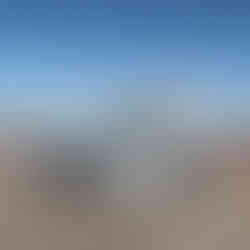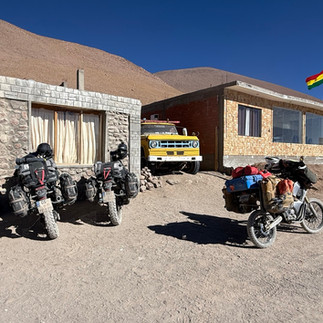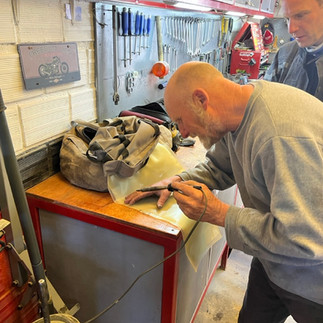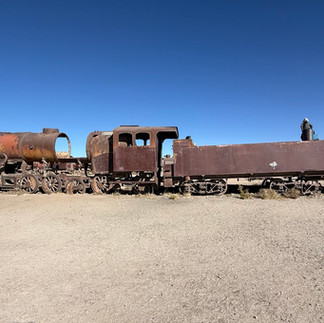Bolivia – Laguna Route & Salar de Uyuni
- Marc/Thilo
- 12. Okt.
- 7 Min. Lesezeit
Aktualisiert: 13. Okt.

Wie schon im letzten Beitrag vorhergesehen, ging es ab der Grenze zwischen Chile und Bolivien auf off-road „Straßen“ weiter. Bevor es aber wirklich losging haben wir uns noch in San Pedro de Atacama mit dem nötigsten in einem Supermarkt eingedeckt. Bis zur Grenzstation über ca. 50km fuhren wir auf wunderbaren Asphalt. Ab der Grenze sind wir von einer Schotterpiste ausgegangen. Die Annahme war daher, dass wir einigermaßen „ok“ durch dieses Hochplateau (immer zwischen 4.200m-5.000m) kommen würden. Des Weiteren wussten wir „nur“, dass diese Strecke auch die „Laguna Route“ genannt wird und bei Touristen sehr beliebt ist. In dem zugehörigen Nationalpark „Eduardo Avaroa National Reserve“ gibt es einiges zu besichtigen. Viele Touristen buchen sich daher auf geführten Touren über 3-6 Tage, um durch diese Gegend zu fahren und sich die Lagunen, Vulkane, Geysire, Thermalquellen, etc. und die Salar de Uyuni anzusehen. Diese Touren fahren mit off-road tauglichen Allrad-Autos (z.B. Landcruisern, etc.) durch diese Gegend. Dies hatte auch seinen Grund.
As predicted in the last post, we continued on off-road “roads” from the border between Chile and Bolivia. But before we really got going, we stocked up on essentials at a supermarket in San Pedro de Atacama. We drove on wonderful asphalt for about 50 km to the border station. From the border, we assumed it would be a gravel road. We therefore assumed that we would be able to get through this high plateau (always between 4,200 m and 5,000 m) reasonably “okay.” Furthermore, we ‘only’ knew that this route is also called the “Laguna Route” and is very popular with tourists. There is a lot to see in the associated national park, “Eduardo Avaroa National Reserve.” Many tourists therefore book guided tours lasting 3-6 days to drive through this area and see the lagoons, volcanoes, geysers, hot springs, etc. and the Salar de Uyuni. These tours drive through this area in off-road four-wheel drive vehicles (e.g., Land Cruisers, etc.). There was a reason for this.
Die Gesamte Strecke bis zur nächsten asphaltierten Straße in Bolivien, außer ein paar kürzere Passagen mit hartem Untergrund, war zu unserem „Erstaunen“ eher eine Sandpiste. Dies erforderte eine sehr hohe andauernde Konzentration beim Fahren zwischen 15-30 km/h. Immer wieder hatte man das Gefühl, dass das Vorderrad wegrutscht, und man sich auf die Seite legen könnte. Alle weiteren Motorradfahren, die wir gesprochen haben (z.B. 2 Amerikaner und ein Neuseeländer) hatten mit der Strecke und einigen Bodenkontakten zu kämpfen. Durch diese Umstände haben wir auch anstatt 2 geplanten Tagen, insgesamt 3 Fahrtage für diese Passage bis nach Uyuni gebraucht. Letztendlich sind wir aber ohne wirklichen Sturz bis nach Uyuni in Bolivien gekommen.
To our surprise, the entire route to the next paved road in Bolivia, except for a few short sections with hard ground, was more of a sandy track. This required a very high level of concentration while driving at speeds between 15-30 km/h. Again and again, we had the feeling that the front wheel was slipping away and we could tip over to the side. All the other motorcyclists we spoke to (e.g., two Americans and a New Zealander) had struggled with the route and had a few falls. Due to these circumstances, instead of the two days we had planned, it took us a total of three days to complete this passage to Uyuni. Ultimately, however, we made it to Uyuni in Bolivia without any real falls.
An unserem ersten Übernachtungsstopp auf 4.400m Höhe, in Chalviri, gab es wohltuende warme Thermalquellen, welche wir auch sehr gerne nach einem anstrengendem Fahrtag in Anspruch genommen haben.
At our first overnight stop at an altitude of 4,400 m, in Chalviri, there were soothing warm thermal springs, which we were very happy to enjoy after a strenuous day of driving.
In Chalviri haben wir auch Alex aus Neuseeland auf seiner Honda CRF 250 getroffen. Er war auch auf dem Weg nach Uyuni. Alex kam vor unsere Unterkunft vorgefahren und hat sich direkt vor unserem Fenster mehr oder weniger im Stand mit dem Motorrad hingelegt. Nach dem Aufstellen war es wieder über den eingesackten Seitenständer im Sand umgekippt. Wir haben Ihm dann geholfen, sein Motorrad vernünftig abzustellen. So lernt man sich natürlich sofort kennen ;). Am nächsten Tag ist Alex dann ein paar Kilometer mit uns gefahren, bevor er dann auf einem Nebenweg zu einem Highlight, der Laguna Colorada, aufgemacht hat. Marc hatte wohl auch Interesse diesen Weg Abseits der Hauptpiste zu nehmen, aber ich (Thilo) wollte nicht. Mir war das alles (auf der eigentlichen Hauptpiste) mit den vollgepackten Motorrädern schon anstrengend genug und ich hatte natürlich auch noch den letzten Sturz und mein lädiertes Knie im Hinterkopf. Also sind wir auf der Hauptpiste geblieben und hatten noch einen Übernachtungsstopp in dem Dorf „Villa Mar“.
In Chalviri, we also met Alex from New Zealand on his Honda CRF 250. He was also on his way to Uyuni. Alex rode up to our accommodation and more or less laid down with his motorcycle right in front of our window. After setting it up, it tipped over again in the sand due to the sunken side stand. We then helped him park his motorcycle properly. That's how you get to know each other right away, of course ;). The next day, Alex rode with us for a few kilometers before turning off onto a side road to a highlight, the Laguna Colorada. Marc was also interested in taking this road off the main track, but I (Thilo) didn't want to. I found it all (on the main track exhausting enough with the fully loaded motorcycles, and of course I still had my recent fall and my injured knee in the back of my mind. So we stayed on the main track and stopped for the night in the village of Villa Mar.
Im Nachgang hatten wir Alex wieder in Uyuni getroffen. Dort hat er, bei einem gemeinsamen Abendessen und 2-3 Bierchen, auch berichtet, dass er sich auf dieser Nebenstrecke durch etlichen tiefen Sand kämpfen musste und einen ordentlichen Sturz hingelegt hatte. Wir sind daher mit der Entscheidung, auf der ebenfalls sandigen Hauptpiste zu bleiben, letztendlich gut zufrieden. Die Landschaft und die Aussichten auf dem Hochplateau waren jedenfalls atemberaubend. Auch wenn wir beim Fahren, durch die „sandigen“ Umstände, nicht wirklich die Zeit hatten, diese ständig zu bewundern ;) Hier nun ein paar weitere Fotos von diesem Abschnitt zwischen San Pedro de Atacama in Chile und Uyuni in Bolivien.
Afterwards, we met Alex again in Uyuni. Over dinner and a couple of beers, he told us that he had struggled through deep sand on this side road and had taken a nasty fall. So we were ultimately very happy with our decision to stay on the main road, which was also sandy. The landscape and views on the high plateau were breathtaking, even if we didn't really have time to admire them constantly while driving due to the “sandy” conditions ;) Here are a few more photos from this section between San Pedro de Atacama in Chile and Uyuni in Bolivia.
In Uyuni angekommen haben wir eine Unterkunft in dem Bahnhof von Uyuni genommen und sind gleich den nächsten Tag auf die touristisch sehr bekannte „Salar de Uyuni“ gefahren. Ein riesiger, meistens trockener, Salzsee, den man mit Fahrzeugen befahren kann. Die bekannte Rally Dakar hatte hier dreimal Station gemacht. Eine mitten in der „Salzwüste“ befindliche Insel mit riesigen Kakteen, zählt ebenfalls zu den touristischen Highlights.
Once we arrived in Uyuni, we found accommodation at the train station and set off the very next day for the famous tourist attraction “Salar de Uyuni.” This is a huge, mostly dry salt lake that can be driven on. The famous Dakar Rally has stopped here three times. An island in the middle of the “salt desert” with giant cacti is also one of the tourist highlights.
Da Alex sein Motorrad nach dem Sturz reparieren lassen musste, kannte er einen Motorrad-Mechaniker vor Ort. Robin, ein Engländer, hat eine sehr gut ausgestatte Werkstatt in Uyuni. Dort konnten wir auch unsere Motorräder, nach der Fahrt auf dem Salzsee, gründlich reinigen und die Kette auch wieder schmieren lassen. Damit hoffen wir, dass die Motorräder und die Ketten nicht anfangen zu rosten. Dort hatte Marc, letztendlich erfolglos, auch versucht seine Tankblase zu flicken. Diese hatte in der Naht eine undichte Stelle und dadurch Benzin verloren. Nun werden wir wohl einen „normalen“ Reservekanister besorgen müssen, um auf den kommenden langen Distanzen nicht liegenzubleiben. Es gibt schlimmeres. Marc bekommt immerhin noch eine neue Reserveblase (über den Anbieter auf Garantiebasis) nach Deutschland gesendet.
Since Alex had to have his motorcycle repaired after the crash, he knew a local motorcycle mechanic. Robin, an Englishman, has a very well-equipped workshop in Uyuni. There we were also able to thoroughly clean our motorcycles after riding on the salt lake and have the chains lubricated again. We hope that this will prevent the motorcycles and chains from starting to rust. Marc also tried to repair his fuel tank bladder there, but ultimately without success. It had a leak in the seam and was losing fuel. Now we'll probably have to get a “normal” spare canister so we don't run out of fuel on the long distances ahead. There are worse things. At least Marc is getting a new spare bladder sent to Germany (covered by warranty).
Ansonsten haben wir in Uyuni die Zeit genutzt, um Wäsche zu machen, sich um den social Media Auftritt zu kümmern und einfach mal ein wenig auszuruhen. Die Stadt Uyuni selbst, hat nicht wirklich viel zu bieten. Sie dient als Ausgangspunkt von Touren für Touristen. Einzig die alten, vor Uyuni sich hin rostenden, Eisenbahnen und Wagons erzählen von der großen Bedeutung Uyunis als Knotenpunkt zum Abtransport von Rohstoffen. Nach einer Bergbaukrise in den 1940er wurden diese Stahlkolosse einfach zurückgelassen. Augenscheinlich diene diese nun auch als ein „Spieleparadies“ für Kinder.
Otherwise, we used our time in Uyuni to do laundry, take care of our social media presence, and just relax a little. The city of Uyuni itself doesn't really have much to offer. It serves as a starting point for tourist tours. Only the old, rusting trains and wagons in front of Uyuni tell of the city's great importance as a hub for the transport of raw materials. After a mining crisis in the 1940s, these steel giants were simply left behind. Apparently, they now also serve as a “playground” for children.
Von hier aus Uyuni aus geht es für uns nun wieder weiter Richtung Süden nach Argentinien. Die „Ruta 40“ durch Argentinien, über rund 5.200km, ist die anvisierte Nord-Süd-Strecke für die nächste Zeit.
From here in Uyuni, we are now heading south again towards Argentina. The “Ruta 40” through Argentina, covering around 5,200 km, is our planned north-south route for the foreseeable future.
Uns geht es gut! Bis bald! We'll be fine and see you soon!











































































































































































































I´m following U from Spain, my colleague and friend Thilo. Good luck and success in such wonderful trip around South America (my birth place)!